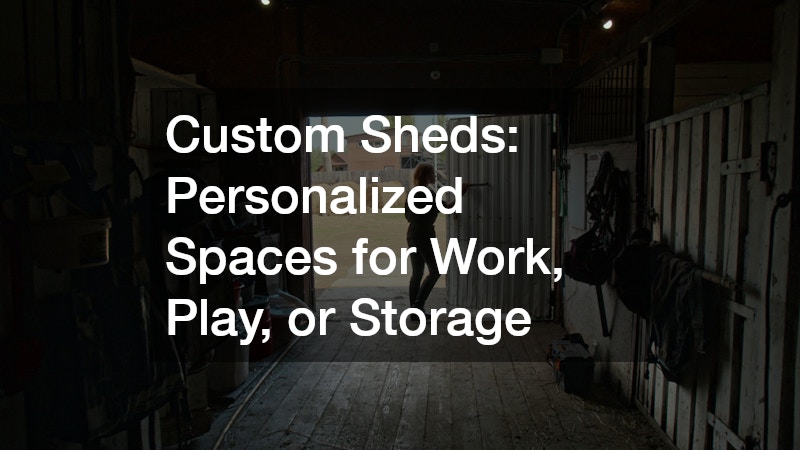Custom sheds have become increasingly popular as homeowners seek personalized solutions for their space needs. Whether for work, play, or storage, custom sheds offer endless possibilities. This article explores common questions and considerations when designing and utilizing a custom shed.
Assessing Your Purpose
Determining the primary use of your custom shed is the first step in the design process. A shed intended for work may require insulation and electricity, while one for play might need open spaces and creative decor. Sheds designed for storage should maximize vertical space and incorporate shelving units to accommodate various items.
Understanding the main purpose helps guide design decisions and ensures the functionality meets your expectations. Functional sheds not only provide utility but also enhance your property’s aesthetics when carefully planned. Customizing the interior to suit your needs ensures that your shed becomes a valuable addition to your home.
Your shed’s purpose will also dictate elements such as lighting and ventilation. Work sheds benefit from natural light and heat regulation, whereas storage sheds might prioritize moisture control. Assessing these needs early can help streamline the design process and reduce future modifications.
Choosing Materials
Selecting the right materials is pivotal in creating a durable and aesthetically pleasing shed. Wood is a traditional choice that offers a warm, natural look but requires maintenance to prevent rot and insect damage. Metal sheds, on the other hand, provide excellent durability and are often more resistant to weather but can be less visually appealing.
Consider the local climate when choosing materials for your custom shed. Areas with high humidity might benefit from metal due to its low moisture retention, while drier climates can accommodate the charm of wood without significant decay risks. The balance between cost, longevity, and visual appeal will influence the material choice.
Innovative materials such as composite wood or recycled plastics offer eco-friendly options with enhanced durability and diverse aesthetic possibilities. These materials can resist the elements effectively while minimizing upkeep. Whichever material you choose, ensure it aligns with the intended functionality of your shed and harmonizes with the surroundings.
Estimating Basic Construction Costs
Understanding the essential costs involved in building a custom shed is crucial for successful budgeting. Start by calculating the cost of materials such as wood, metal, or composites, and factor in expenses for hardware and finishes. Labor costs can vary significantly depending on your location and the complexity of the shed’s design.
Permits may also be required, adding to the initial expenses of the project. It’s important to research local regulations to avoid unexpected fines or delays. The size and complexity of your shed can greatly influence construction costs, so carefully plan its dimensions and features to align with your budget.
Additional features like electrical wiring or plumbing installations should be budgeted from the start. These elements can enhance a shed’s functionality but increase the upfront costs. Investing time in detailed planning will ensure you allocate funds efficiently across all aspects of your shed project.
Integrating Technology and Utilities
Incorporating technology and utilities can significantly enhance the usability of a custom shed. Energy-efficient lighting provides ample illumination while minimizing electricity consumption. Adding electrical outlets and wiring can support various devices, making the shed suitable for work or leisure activities.
Installing broadband connectivity can transform a shed into a productive home office or entertainment venue. Climate control systems like heating and air conditioning ensure comfort throughout the year, regardless of local weather conditions. Considering these technological upgrades from the onset will integrate seamlessly into the overall design.
Solar panels or other renewable energy sources offer sustainable ways to power electrical amenities in the shed. These investments not only reduce long-term energy costs but also contribute positively to the environment. By harnessing technology, homeowners can create a modern and accommodating retreat within their backyard.
Enhancing Security Features
Securing your custom shed is essential to protect valuables and maintain peace of mind. Robust lock systems, such as deadbolts or keypad entries, can deter unauthorized access. Advanced security systems may include surveillance cameras that provide real-time monitoring and motion detection.
Strategically placed outdoor lighting enhances visibility and can deter potential intruders. Simple measures, like trimming back overgrown foliage around the shed, also improve visibility and reduce hiding spots. Upgrading door and window locks with high-quality fixtures strengthens security and prevents breaches.
A comprehensive security plan not only safeguards contents but also enhances the shed’s integration with the property. Consider insurance policies specifically designed to cover sheds and their contents. By proactively investing in security measures, homeowners protect their investments and ensure the longevity of their custom space.
Custom sheds offer versatile solutions tailored to individual needs, whether for work, play, or storage. By considering design, cost, and functionality, homeowners can create efficient and personalized spaces. These sheds not only enhance utility but also add value to properties, making them a worthwhile investment for any homeowner seeking additional space.
.



